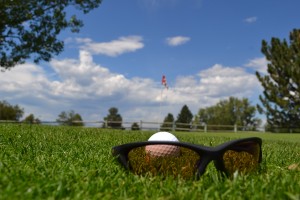There is always a lot of marketing talk about new prescription technology. It’s always the latest and greatest, obviously. Usually there are accompanying, stylish ads with cool graphics showing rays of light or lines of vision as they pass through a lens. Or it’s the old split-screen between “their” lenses and “our” lenses, in which “our” lenses are always crystal clear and bright and everyone is smiling and “their” lenses look like a blurry doom. But really, all of the good companies (and those are the companies I’m talking about, the ones who make a good, respectable product) are using very similar lens materials – most of us get them from the same sources. And all of these companies have some very nice, state-of-the-art machinery to make lenses. They press a button and out pops a lens. Tada! That’s how a pair of five hundred dollar glasses get made, by the press of a button in a manufacturing lab somewhere.It’s a far cry from the intimacy and personality of a Golf Rx lens, but company character aside, the difference is in knowing what to program into those machines. It’s in understanding the real world application of what those machines pop out and being able to consider a dozen different factors that go into of a piece of prescription eyewear and knowing how to put it all together to create a pair of glasses that will work for each individual wearer, all of whom has a unique prescription with unique needs. The difference is in attention to detail and it’s in a strong, necessary desire for perfection, because in something like optics anything less than perfect is, simply, less than clear.
A Serious Article for a Serious Topic
There is always a lot of marketing talk about new prescription technology. It’s always the latest and greatest, obviously. Usually there are accompanying, stylish ads with cool graphics showing rays of light or lines of vision as they pass through a lens. Or it’s the old split-screen between “their” lenses and “our” lenses, in which “our” lenses are always crystal clear and bright and everyone is smiling and “their” lenses look like a blurry doom. But really, all of the good companies (and those are the companies I’m talking about, the ones who make a good, respectable product) are using very similar lens materials – most of us get them from the same sources. And all of these companies have some very nice, state-of-the-art machinery to make lenses. They press a button and out pops a lens. Tada! That’s how a pair of five hundred dollar glasses get made, by the press of a button in a manufacturing lab somewhere.It’s a far cry from the intimacy and personality of a Golf Rx lens, but company character aside, the difference is in knowing what to program into those machines. It’s in understanding the real world application of what those machines pop out and being able to consider a dozen different factors that go into of a piece of prescription eyewear and knowing how to put it all together to create a pair of glasses that will work for each individual wearer, all of whom has a unique prescription with unique needs. The difference is in attention to detail and it’s in a strong, necessary desire for perfection, because in something like optics anything less than perfect is, simply, less than clear.


